lock Acura TL 2000 3.2 User Guide
[x] Cancel search | Manufacturer: ACURA, Model Year: 2000, Model line: TL, Model: Acura TL 2000Pages: 311, PDF Size: 3.05 MB
Page 34 of 311
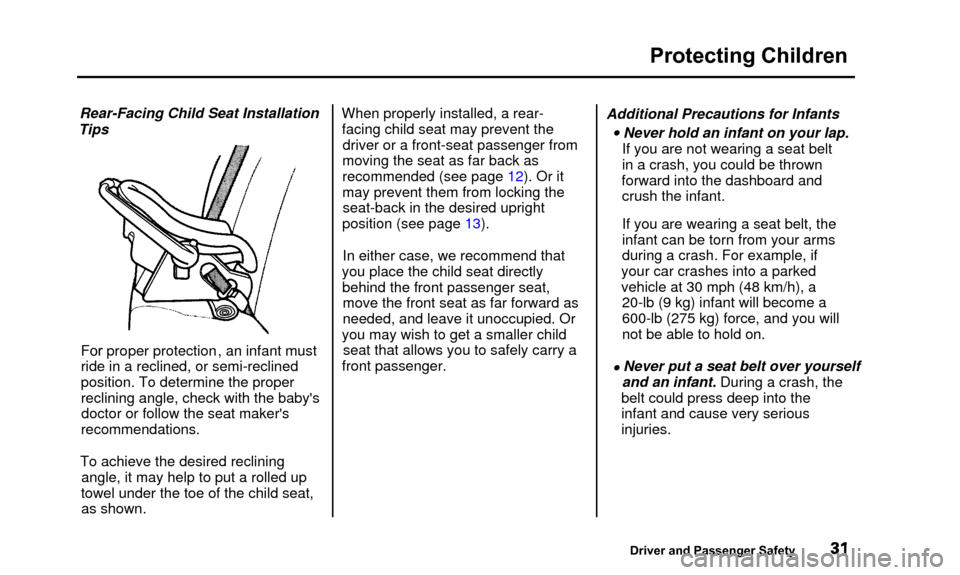
Protecting Children
Rear-Facing Child Seat Installation
Tips
For proper protection, an infant must
ride in a reclined, or semi-reclined
position. To determine the proper
reclining angle, check with the baby's doctor or follow the seat maker's
recommendations.
To achieve the desired reclining angle, it may help to put a rolled up
towel under the toe of the child seat, as shown. When properly installed, a rear-
facing child seat may prevent the driver or a front-seat passenger from
moving the seat as far back as
recommended (see page 12). Or it may prevent them from locking the seat-back in the desired upright
position (see page 13).
In either case, we recommend that
you place the child seat directly behind the front passenger seat,move the front seat as far forward as
needed, and leave it unoccupied. Or
you may wish to get a smaller child seat that allows you to safely carry a
front passenger. Additional Precautions for Infants
• Never hold an infant on your lap.
If you are not wearing a seat belt
in a crash, you could be thrown
forward into the dashboard and crush the infant.
If you are wearing a seat belt, theinfant can be torn from your arms
during a crash. For example, if
your car crashes into a parked
vehicle at 30 mph (48 km/h), a 20-lb (9 kg) infant will become a
600-lb (275 kg) force, and you will
not be able to hold on.
• Never put a seat belt over yourself and an infant. During a crash, the
belt could press deep into the
infant and cause very serious
injuries.
Driver and Passenger Safety
Page 36 of 311
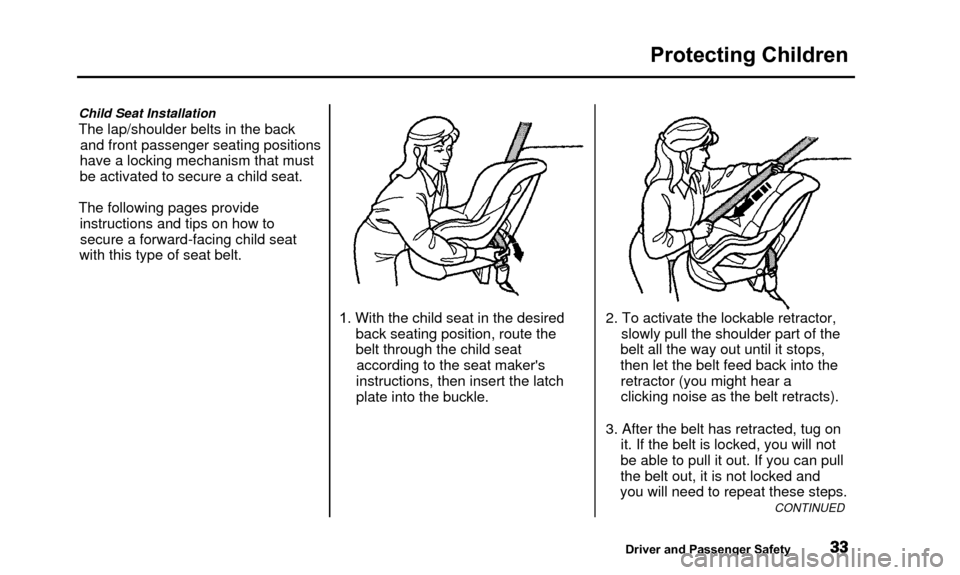
Protecting Children
Child Seat Installation
The lap/shoulder belts in the backand front passenger seating positions
have a locking mechanism that must
be activated to secure a child seat.
The following pages provide instructions and tips on how tosecure a forward-facing child seat
with this type of seat belt.
1. With the child seat in the desiredback seating position, route the
belt through the child seataccording to the seat maker's
instructions, then insert the latch
plate into the buckle. 2. To activate the lockable retractor,
slowly pull the shoulder part of the
belt all the way out until it stops,
then let the belt feed back into the retractor (you might hear a
clicking noise as the belt retracts).
3. After the belt has retracted, tug on it. If the belt is locked, you will not
be able to pull it out. If you can pull
the belt out, it is not locked and
you will need to repeat these steps.
CONTINUED
Driver and Passenger Safety
Page 37 of 311
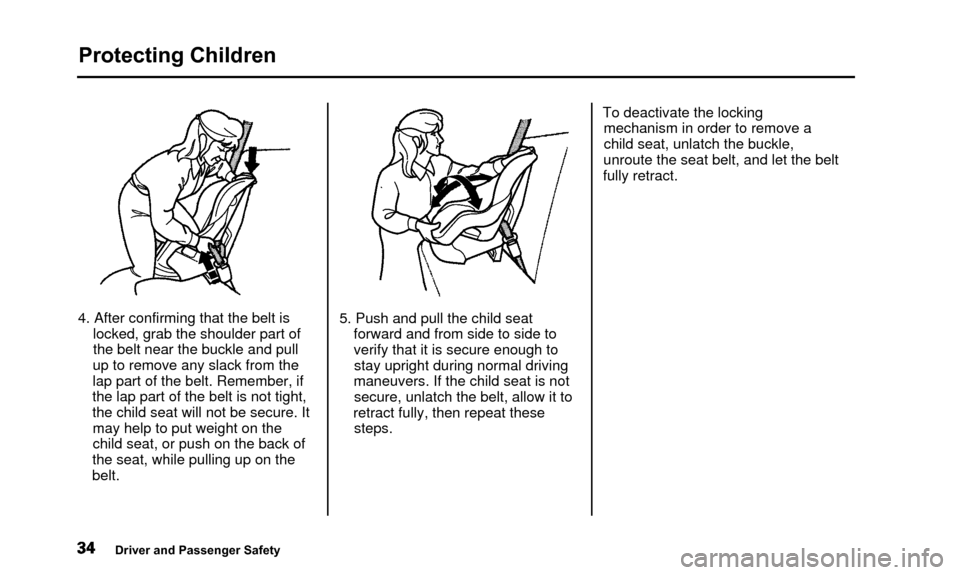
Protecting Children
4. After confirming that the belt islocked, grab the shoulder part of
the belt near the buckle and pull
up to remove any slack from the
lap part of the belt. Remember, if
the lap part of the belt is not tight,
the child seat will not be secure. It may help to put weight on the
child seat, or push on the back of
the seat, while pulling up on the
belt. 5. Push and pull the child seat
forward and from side to side to
verify that it is secure enough tostay upright during normal driving
maneuvers. If the child seat is not secure, unlatch the belt, allow it to
retract fully, then repeat these steps. To deactivate the locking
mechanism in order to remove a
child seat, unlatch the buckle,
unroute the seat belt, and let the belt
fully retract.
Driver and Passenger Safety
Page 43 of 311
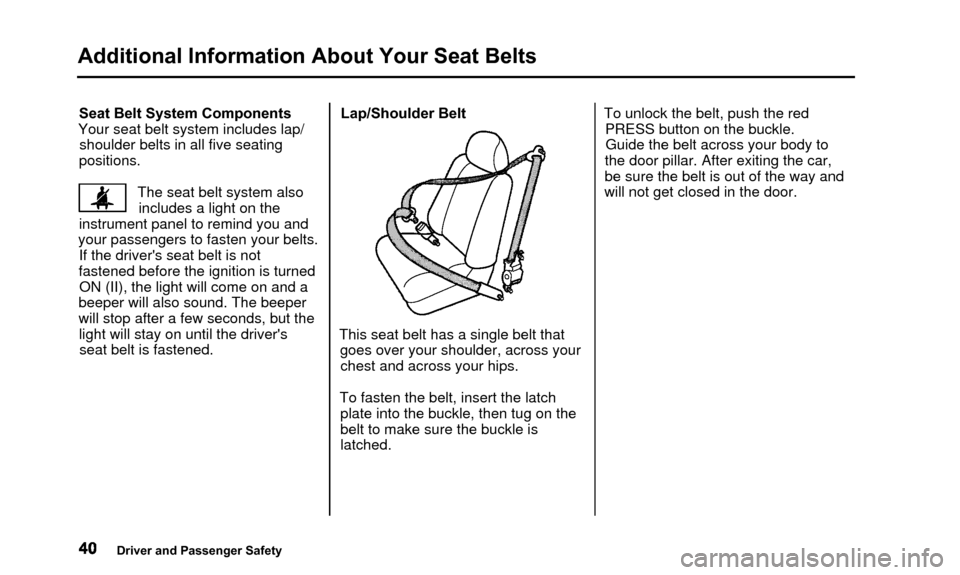
Additional Information About Your Seat Belts
Seat Belt System Components
Your seat belt system includes lap/ shoulder belts in all five seating
positions.
The seat belt system alsoincludes a light on the
instrument panel to remind you and
your passengers to fasten your belts. If the driver's seat belt is not
fastened before the ignition is turned ON (II), the light will come on and a
beeper will also sound. The beeper
will stop after a few seconds, but the light will stay on until the driver'sseat belt is fastened. Lap/Shoulder Belt
This seat belt has a single belt that goes over your shoulder, across yourchest and across your hips.
To fasten the belt, insert the latch plate into the buckle, then tug on the
belt to make sure the buckle islatched. To unlock the belt, push the red
PRESS button on the buckle.Guide the belt across your body to
the door pillar. After exiting the car,
be sure the belt is out of the way and
will not get closed in the door.
Driver and Passenger Safety
Page 44 of 311
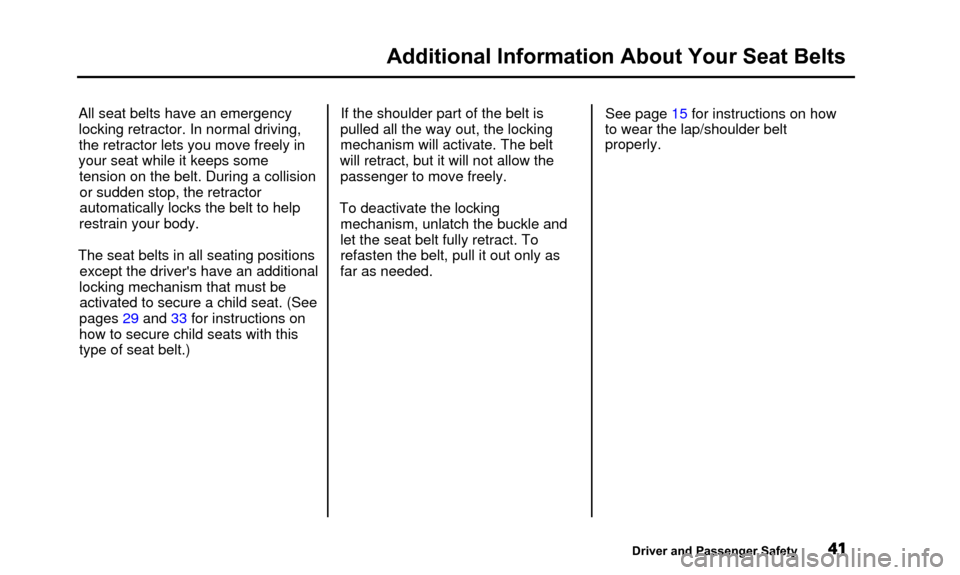
Additional Information About Your Seat Belts
All seat belts have an emergencylocking retractor. In normal driving,
the retractor lets you move freely in
your seat while it keeps some tension on the belt. During a collisionor sudden stop, the retractor
automatically locks the belt to help
restrain your body.
The seat belts in all seating positions except the driver's have an additional
locking mechanism that must be activated to secure a child seat. (See
pages 29 and 33 for instructions on
how to secure child seats with this type of seat belt.) If the shoulder part of the belt is
pulled all the way out, the locking
mechanism will activate. The belt
will retract, but it will not allow the passenger to move freely.
To deactivate the locking mechanism, unlatch the buckle and
let the seat belt fully retract. To
refasten the belt, pull it out only as
far as needed. See page 15 for instructions on how
to wear the lap/shoulder belt
properly.
Driver and Passenger Safety
Page 54 of 311
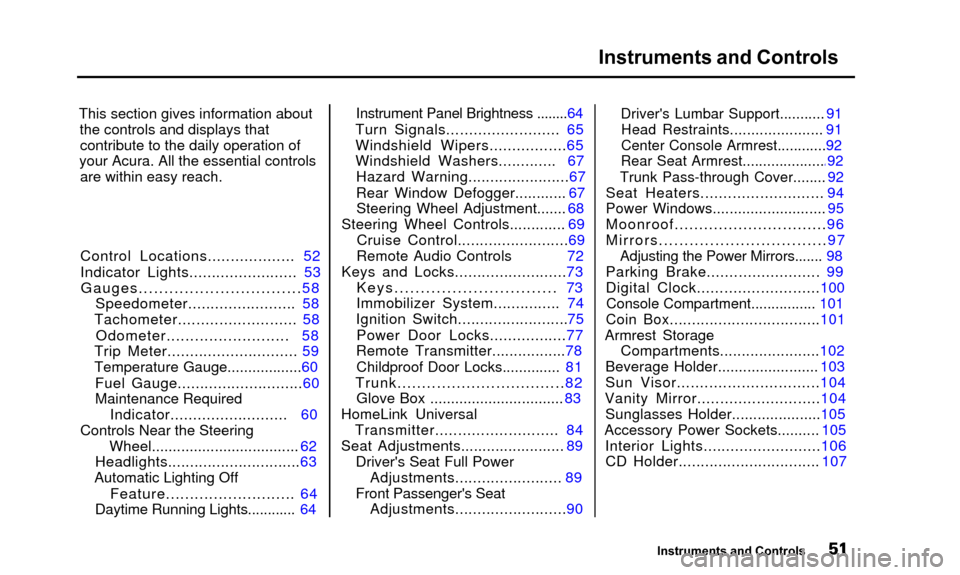
Instruments and Controls
This section gives information aboutthe controls and displays thatcontribute to the daily operation of
your Acura. All the essential controls are within easy reach.
Control Locations................... 52
Indicator Lights........................ 53
Gauges................................58
Speedometer........................ 58
Tachometer.......................... 58
Odometer.......................... 58
Trip Meter............................. 59
Temperature Gauge..................60
Fuel Gauge............................60
Maintenance Required Indicator.......................... 60
Controls Near the Steering
Wheel................................... 62
Headlights..............................63
Automatic Lighting Off
Feature........................... 64
Daytime Running Lights............ 64
Instrument Panel Brightness ........64
Turn Signals......................... 65
Windshield Wipers.................65
Windshield Washers............. 67 Hazard Warning....................... 67
Rear Window Defogger............ 67
Steering Wheel Adjustment....... 68
Steering Wheel Controls............. 69 Cruise Control.........................69
Remote Audio Controls 72
Keys and Locks.........................73
Keys............................... 73
Immobilizer System............... 74
Ignition Switch ......................... 75
Power Door Locks.................77
Remote Transmitter.................78
Childproof Door Locks.............. 81
Trunk.................................. 82
Glove Box ................................ 83
HomeLink Universal Transmitter........................... 84
Seat Adjustments........................ 89
Driver's Seat Full PowerAdjustments........................ 89
Front Passenger's Seat Adjustments.........................90
Driver's Lumbar Support........... 91Head Restraints...................... 91
Center Console Armrest............92
Rear Seat Armrest....................4 92
Trunk Pass-through Cover........ 92
Seat Heaters........................... 94
Power Windows........................... 95
Moonroof...............................96
Mirrors.................................97
Adjusting the Power Mirrors....... 98
Parking Brake......................... 99
Digital Clock...........................100
Console Compartment................ 101
Coin Box..................................101
Armrest Storage
Compartments.......................102
Beverage Holder........................ 103
Sun Visor...............................104
Vanity Mirror........................... 104
Sunglasses Holder.....................105
Accessory Power Sockets.......... 105
Interior Lights..........................106
CD Holder................................ 107
Instruments and Controls
Page 55 of 311
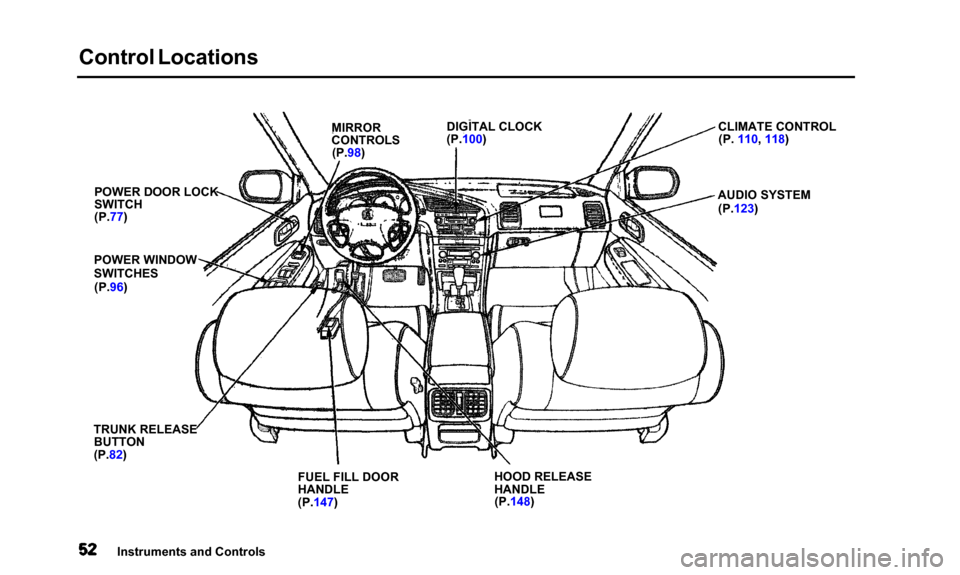
Control Locations
POWER DOOR LOCK
SWITCH
(P.77)
POWER WINDOW
SWITCHES (P.96)
TRUNK RELEASE BUTTON
(P.82)
FUEL FILL DOOR
HANDLE
(P.147)HOOD RELEASE
HANDLE
(P.148) CLIMATE CONTROL
(P. 110, 118)
AUDIO SYSTEM (P.123)
Instruments and Controls DIGITAL CLOCK
(P.100)
MIRROR
CONTROLS
(P.98)
Page 56 of 311
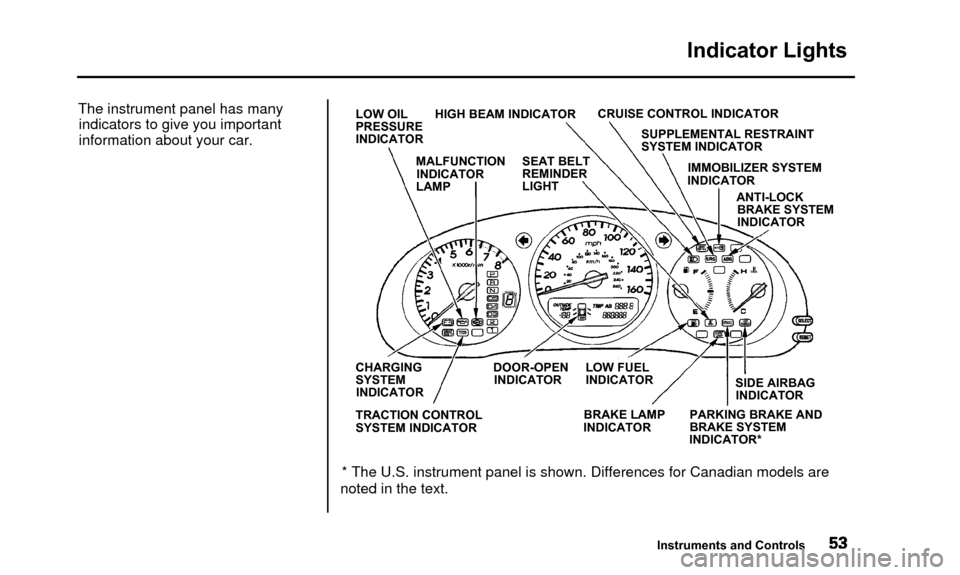
Indicator Lights
The instrument panel has manyindicators to give you important
information about your car.LOW OIL HIGH BEAM INDICATOR
PRESSURE
INDICATOR CRUISE CONTROL INDICATOR
SUPPLEMENTAL RESTRAINT
SYSTEM INDICATOR
IMMOBILIZER SYSTEM
INDICATOR
ANTI-LOCKBRAKE SYSTEM
INDICATOR
CHARGING DOOR-OPEN LOW FUEL
SYSTEM INDICATOR INDICATOR INDICATOR
TRACTION CONTROL
SYSTEM INDICATOR BRAKE LAMP
INDICATOR SIDE AIRBAG
INDICATOR
PARKING BRAKE AND
BRAKE SYSTEM
INDICATOR*
* The U.S. instrument panel is shown. Differences for Canadian models ar\
e
noted in the text.
Instruments and Controls
MALFUNCTION
INDICATOR
LAMP SEAT BELT
REMINDER
LIGHT
Page 58 of 311
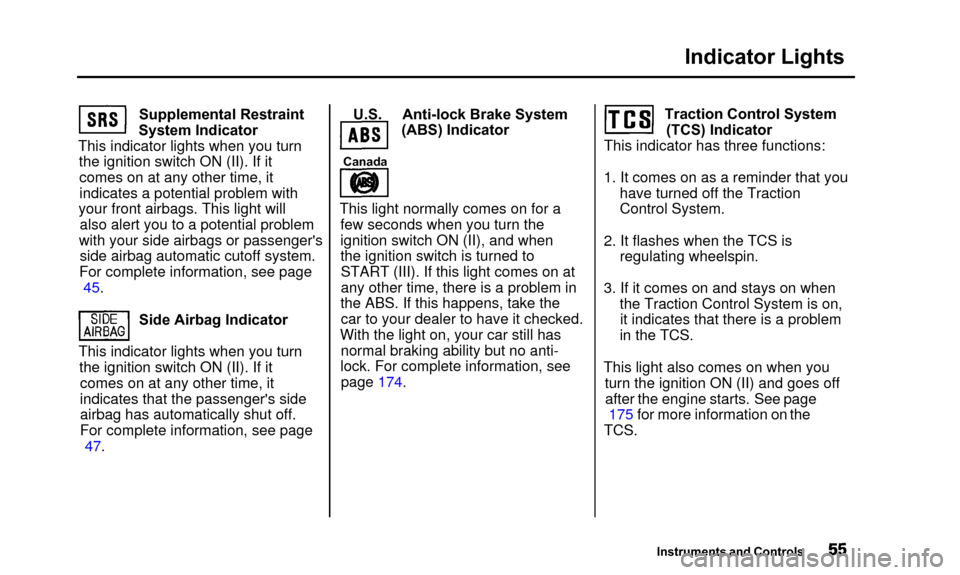
Indicator Lights
Supplemental Restraint
System Indicator
This indicator lights when you turn the ignition switch ON (II). If itcomes on at any other time, it
indicates a potential problem with
your front airbags. This light will also alert you to a potential problem
with your side airbags or passenger's side airbag automatic cutoff system.
For complete information, see page 45.
Side Airbag Indicator
This indicator lights when you turn the ignition switch ON (II). If itcomes on at any other time, it
indicates that the passenger's side
airbag has automatically shut off.
For complete information, see page 47. U.S. Anti-lock Brake System
(ABS) Indicator
Canada
This light normally comes on for a
few seconds when you turn the
ignition switch ON (II), and when
the ignition switch is turned toSTART (III). If this light comes on at
any other time, there is a problem in
the ABS. If this happens, take the car to your dealer to have it checked.
With the light on, your car still has normal braking ability but no anti-
lock. For complete information, see page 174. Traction Control System
(TCS) Indicator
This indicator has three functions:
1. It comes on as a reminder that you have turned off the TractionControl System.
2. It flashes when the TCS is regulating wheelspin.
3. If it comes on and stays on when the Traction Control System is on,it indicates that there is a problem
in the TCS.
This light also comes on when you turn the ignition ON (II) and goes offafter the engine starts. See page 175 for more information on the
TCS.
Instruments and Controls
Page 60 of 311
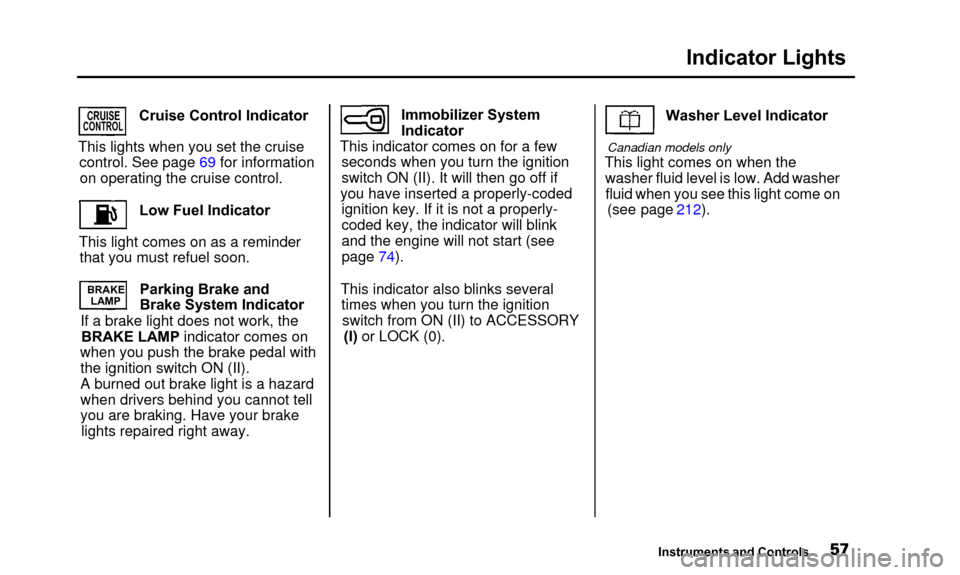
Indicator Lights
CRUISECONTROLCruise Control Indicator
This lights when you set the cruise control. See page 69 for informationon operating the cruise control.
Low Fuel Indicator
This light comes on as a reminder that you must refuel soon.
BRAKE LAMPParking Brake and
Brake System Indicator
If a brake light does not work, the BRAKE LAMP indicator comes on
when you push the brake pedal with the ignition switch ON (II).
A burned out brake light is a hazard
when drivers behind you cannot tell
you are braking. Have your brake lights repaired right away. Immobilizer System
Indicator
This indicator comes on for a few seconds when you turn the ignition
switch ON (II). It will then go off if
you have inserted a properly-coded ignition key. If it is not a properly-
coded key, the indicator will blink
and the engine will not start (see
page 74).
This indicator also blinks several times when you turn the ignition switch from ON (II) to ACCESSORY (I) or LOCK (0). Washer Level Indicator
Canadian models only
This light comes on when the
washer fluid level is low. Add washerfluid when you see this light come on (see page 212).
Instruments and Controls